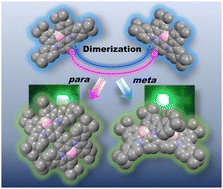Facile dimerization strategy for producing narrowband green multi-resonance delayed fluorescence emitters†
Abstract
Establishing a simple molecular design strategy for enabling redshifted emissions while maintaining high color purity in multi-resonance thermally activated delayed fluorescence (MR-TADF) remains a crucial yet challenging task. Herein, we introduce a new design concept based on a dimerization strategy for constructing pure green MR-TADF emitters. Two isomeric MR dimers, namely p-CzB and m-CzB, were developed by tethering two MR fragments through different linking positions. The interconnection mode between the two MR fragments in these dimeric MR-TADF systems plays a vital role in regulating photophysical properties as well as exciton dynamics. Comprehensive photophysical and computational studies revealed that m-CzB exhibits superior green MR-TADF characteristics compared to p-CzB. A m-CzB-based organic light-emitting diode (OLED) delivered pure green electroluminescence with CIE coordinates of (0.20, 0.70), a maximum external quantum efficiency of 23.5%, and alleviated efficiency roll-off.

- This article is part of the themed collection: 2023 Journal of Materials Chemistry C Most Popular Articles


 Please wait while we load your content...
Please wait while we load your content...